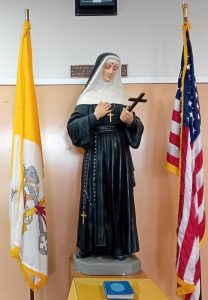
The story of St. Rita of Cascia is an inspiring tale of a little pious girl who grew up in virtue, despite the thorns strewn along her path of growth. Margherita Lotti was her original name, but over the years was shortened to Rita. She was born in the year 1381 in the city of Roccaporena, in the suburbs of Cascia, Italy.
By the time of her death on May 22, 1457, St. Rita had left humanity with a legacy of patience, trust in God, dedication, and a peacemaker. Given the prevalent culture of the time, she was literally denied of her childhood as she was given off in marriage at the age of 12. In a life steeped in the passion of Christ, she experienced lots of abuse in marriage as her husband Paolo Mancini was quick-tempered and cultivated tons of enemies in the Cascia region. Each day for the 18 years that the marriage lasted, St. Rita navigated these difficult experiences while bringing up her 2 sons (Giangiacomo Giovanni Antonio and Paulo Maria).
With characteristic humility, kindness, and patience, she was able to convert her husband. Unfortunately, she had to endure the pain of the loss of her husband after 18 years of marriage, because he went back to his old life of inter-family feuds with the Chiqui family in Cascia and was stabbed to death by Guido Chiqui. In a profound expression of her exceptional spirituality during the funeral of her husband, she forgave those who killed him. However, the Cross would show up again in the life of St. Rita, when her brother-in-law Bernado convinced her two sons to join in seeking vendetta on those who killed their father. When she failed to convince them to seek the way of forgiveness instead of vendetta, she prayed to God to completely remove her sons from that space full of murderous tendencies. Following an outbreak of dysentery a year later, both of her sons died.
Having lost her husband and two sons, St. Rita sought entrance to the monastery of St. Mary Magdalene in her native Cascia. In childhood, her sole aim was to serve God as a nun, the prevailing tradition then found her being given off in marriage. She was initially refused admission. She never lost trust in God, but persisted and was finally admitted to religious life on the condition that she helped to reconcile feuding families in Cascia. Imploring the intercession of her patron saints, John the Baptist, Augustine of Hippo, and Nicholas of Tolentino, her brother-in-law relinquished violence and peace returned to Cascia (while she prayed to her patron saints, the bubonic plague ravaged parts of Italy and Bernado contracted the virus – which made him to abandon the way of violence). At the age of 36, she was finally admitted to religious life.
There are three unique things for which St. Rita is identified. The first is the wound on her forehead, which occurred when St. Rita was about 60 years old and was praying before the Crucifix. She became a stigmata from then on. The second is a very profound expression of how Christ’s passion was stamped on her life, the roses. They represent what happened toward the end of her life when one of her cousins visited her. Her cousin asked if she could bring St. Rita a gift from her old house, and St. Rita requested that she bring her a rose. Being the month of January in Cascia, that was a practical impossibility, but upon getting home, she was amazed to find a single rose fully grown in the garden, which she brought to St. Rita. The third is the photo of bees, which was an experience St. Rita had shortly after her baptism in infancy. While she slept, her family observed white bees going into her mouth and coming out without hurting her. It was a mystical experience for her family, and from then they knew her life would be a great example of virtue and devotion.
Known as the unofficial patroness of baseball, St Rita together with St. Jude Thaddeus and St. Philomena, are known as saints of impossible situations. She is equally addressed as the patron saint of those suffering from sterility, as well as abuse victims, lonely people, difficult marriages, widows, the sick, bodily ills, wounds, and parenthood. She was buried in Cascia, where her body is venerated at a shrine dedicated to her.
In line with the vision of the Archdiocese of Cincinnati towards the well-being of the Deaf in the Archdiocese, the late Archbishop Henry Moeller in the early 1900s informed Father Henry J. Walhaus to devote his services to the education of the Deaf, and the Sisters of Charity of Cincinnati to supply the teachers for the commissioning of a Deaf school built on a plot of land purchased around Evandale axis. The school for the Deaf was named after St. Rita of Cascia at the request of Mother Mary Florence Kent, the Mother Superior of the Sisters of Charity of Cincinnati. The reason for choosing St. Rita was not documented properly.
However, at the early stage of the school, St. Rita’s School for the Deaf experienced difficulties of low funding and in fact, relied on some of the buildings in the school for classrooms and dormitories. The Sisters lived with the Deaf girls in one building, and Fr. Waldhaus lived with the boys in the other building. Sooner or later, the impossibility of funding the school due to little resources available and the impossibility of transferring the new method of teaching to the Deaf children whom society at that time considered as liabilities and burdens, became reality and something possible courtesy of prayers, charity, and intersessions of St. Rita of Cascia whom the school is named after and who is known as a great saint of impossible situations.
St. Rita of Cascia, pray for us.
